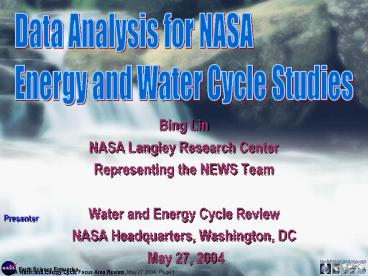Bing Lin PowerPoint PPT Presentation
1 / 15
Title: Bing Lin
1
Data Analysis for NASA Energy and Water Cycle
Studies
- Bing Lin
- NASA Langley Research Center
- Representing the NEWS Team
- Water and Energy Cycle Review
- NASA Headquarters, Washington, DC
- May 27, 2004
2
Why Analysis? Understanding
- Extracting Scientific Information
- theories and hypothesis
- Understanding Natural Variability
- point/weather to global/long term scales
- Improving Modeling and Prediction
- comparison and validation
3
Key Areas
- Use existing datasets
- GPCP, ISCCP, ERBE/CERES, MSU/AMSU
- Develop new climate data products
- ARM, BSRN, CloudSat, Calipso, heating profiles,
SeaFlux - Characterize weather and longer/larger scale
variations of WEC - Forcings, trends, teleconnections, and physical
relationships - Improve the accuracy of precipitation and
evaporation estimations - TRMM, GPM, SMOS, HYDRO, land/ice/ocean, merge all
fluxes - Develop advanced non-linear, multi-variation
analysis technique - Integration, neural network, multiple feedback
processes
4
Use Existing Datasets
Why are the trends different? analysis of
datasets uncertainties
- Analyze differences in these datasets
- Collocate multiple records
- consistent time series
- Derive atmospheric state circulation data
- Seek improvements in divergent wind field
analysis - Reprocess historical data
- cooperation with partners
- Assemble a complete description of WEC within
15
Surf. temp. anomalies
MSU temp. anomalies
from GISS GHCC
5
Develop New Climate Data Products
EOS Terra and Aqua - MODIS, CERES -
AMSU/AIRS/AMSR A-train added observations
- CALIPSO 80 penetration to top of boundary
layer - CloudSat radar adds profiles of deep
convective clouds
- Cloud Radiative Forcing
- The threshold temperature dividing mixed-phase
and ice clouds is not well known - Ice/water partitioning is an important modulator
of the climate sensitivity in climate models - Unique CALIPSO CloudSat observations
- - improved ice/water phase, vertically
resolved - - Calipso for IWP of thin clouds
- - CloudSat for moderate to thick clouds
from LaRC
6
Characterize the Variability of WEC
- ERBE/CERES radiation data
- Significant decadal variations
- Too small for rainfall measurements
- Accelerated hydrological cycle (?)
- ERBE/CERES ISCCP data
- increase deep convection
- decrease lower clouds
subtrop. equatorial
Radiative Anomalies (W/m2)
from Wielickie et al. and Chen et al. 2002
7
Improve the Accuracy of P and E
Comparison between pentad GPCP and gauge-based
observations GPM higher accuracies
Improvements instrumental cal./val. spatial and
temporal sampling long-term monitoring, new
datasets merging multiple analysis
from Xie et al. 2003, JC
8
Develop Advanced Techniques
Multi-variate analysis
Over polar ice sheets, water amounts of low
clouds increase with temperature producing
negative cloud climate feedback.
f 3.3/K
Sea ice albedo feedback, i.e., increasing
surface temperature decreases sea ice coverage,
reduces the surface albedo and increases solar
insulation, is general positive. So, what is the
combined effects of clouds and sea ice? Multiple
feedbacks?
from Lin et al. 2003, JGR
9
Phase 1 Milestones
- Obtain more accurate global P and E fluxes
- Reduce uncertainties in describing global WEC by
50 - Identify missing elements and develop new
datasets (e.g., latent heat and heating
profiles) - Quantify predictability of WEC variations at all
spatial scales - Develop diagnostic techniques for climate
feedbacks and responses
10
Milestones of Phases 2 and 3
- Investigations of causes of natural variability
using - multi-variate analysis techniques
- Discriminate between forced and unforced climate
responses - Assess climate variability (short time scales)
and forcing (longer time scales) - Assess the predictability of energy and water
variations on range of space and time scales - Characterize the slower feedback processes that
effect the energy and water cycles
11
backup
12
Use Existing DatasetsMulti-decadal Radiation
Data Record
1983
2005
2010
2000
1995
1990
Time
ISCCP
Continue?
Improve Overlap with EOS, intercalibrate with
ERBS
SRB Project
Continue?
Future releases?
WRDC/NREL, NOAA CMDL, Field Experiments, misc.
Surface Obs
BSRN, SURFRAD, ARM
50 Gap Risk
CERES
SCARAB-1
ERBE
NPOESS
ERB Missions
ERBS Nonscanner
GERB
TRMM, Terra, Aqua, CALIPSO CloudSat
EOS/ESSP Missions
13
Develop Advanced Techniques
Non-linear analysis
SSM/I for Net sfc LW SSM/I channels WV, LWP,
Tw, sfc Results Neural Network much better,
close to physically calculations
- Non-linear, multi-variation analysis
- Fast data fusing and retrieving
- Diagnosing non-linear processes
- Investigating feedbacks
from Liu et al. 1997, JAM Gupta et al. 2004,
JAOT
14
The Energy Cycle
from Kiehl and Trenberth, BAMS 97
15
The Vertical CALIPSO Aerosol
- Aerosol Direct Radiative Forcing
- CALIPSO aerosol profiles
- - enable back-trajectories to aerosol sources
- 4-D assimilation of aerosol profiles
- - constrains uncertainties in source/transport
- models
- - partitioning of natural, anthropogenic
forcings - A-train CALIPSO MODIS CERES - improved
surface SW fluxes
- Aerosol Indirect Radiative Forcing
- CALIPSO cloud and aerosol profiles -
unique ability to determine if cloud and
aerosol are in the same layer. - A-train add MODIS CERES - cloud
microphysics, optics, radiation - A-train add AMSR, Cloudsat radar -
adds LWP plus drizzle.
Cirrus
Low Cloud
Sahara dust
from Winker/LaRC

